Music of Lukas Foss – A Recording Review and Reflective Tribute by Dana Paul Perna
Comments Off on Music of Lukas Foss – A Recording Review and Reflective Tribute by Dana Paul PernaJuly 9, 2024 by Admin
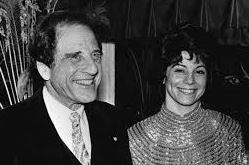
Lukas Foss: Ode, Renaissance Concerto, Three American Pieces, Symphony No. 1
Buffalo Philharmonic Orchestra/JoAnn Falletta, conducting
Amy Porter, flute, Nikki Chooi, violin
Naxos American Classics Series CD No. 8.559938
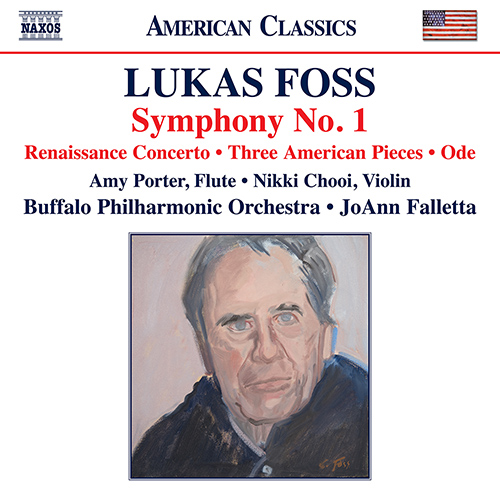 2022 marked the centennial of the birth of the truly remarkable Lukas Foss (1922-2009). One of America’s truly great talents, his centenary was as unceremoniously acknowledged in 2022 as was his passing in 2009. Born in Berlin, having studied as a youth in Paris before moving to the United States in 1937 to fully escape the Nazis, Foss enrolled at the Curtis Institute of Music where he met a classmate named Leonard Bernstein – you may have heard of him, forming an enduring friendship that lasted until Lenny’s passing in 1990.
2022 marked the centennial of the birth of the truly remarkable Lukas Foss (1922-2009). One of America’s truly great talents, his centenary was as unceremoniously acknowledged in 2022 as was his passing in 2009. Born in Berlin, having studied as a youth in Paris before moving to the United States in 1937 to fully escape the Nazis, Foss enrolled at the Curtis Institute of Music where he met a classmate named Leonard Bernstein – you may have heard of him, forming an enduring friendship that lasted until Lenny’s passing in 1990.
The list of teachers with whom Foss studied reads like a who’s who of music: composition at Tanglewood (inaugural classes, in fact) with Paul Hindemith, and at Curtis with Rosario Scalero, orchestration with Randall Thompson (at Curtis), conducting at Curtis with Fritz Reiner, and at Tanglewood with Serge Koussevitzky who subsequently appointed Foss to become pianist of the Boston Symphony Orchestra, piano with Isabelle Vengerova (at Curtis) and Lazare Levy (in Paris), all of which supports the reason why Lukas successfully wore so many hats. Past his significant output of compositions, as a teacher he was hired to replace no less a figure than Arnold Schoenberg at UCLA, later serving on the faculty of Boston University, serving as music director of the Ojai Music Festival (1961-1987), founding the Center of the Creative and Performing Arts in 1963 while at the State University of New York at Buffalo, as well as forging noteworthy music director appointments with the Buffalo Philharmonic Orchestra (1963-1970), Brooklyn Philharmonic Orchestra (1971-1988), and the Milwaukee Symphony Orchestra (1981-1986). He was awarded a Gold Medal by the American Academy of Arts and Letters in 2000. At one time, he toured cities in Iron Curtain Countries with Aaron Copland.
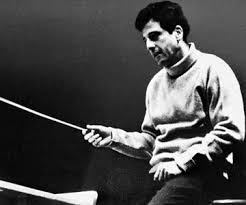 My first contact with Maestro Foss occurred during a summer festival at which time I also met Elliot Carter, Bayan Northcott, David Starobin, and Meyer Kupferman. At the last minute, and on a borrowed cornet, I played under his baton on what was to have been a complete performance of an extended opus by him, choosing, in the end, to perform only two of its movements. What I was to learn at a later time was his appearance, concert, and all else happened during a less-than-the-best period of his life, meaning that the impression he left on all of us was equally, I am afraid to print this, less-than-the-best…..and I will leave it at that. Years later……well, allow me to proceed with the reason for this entry, permitting me to return to further reflections later in this article.
My first contact with Maestro Foss occurred during a summer festival at which time I also met Elliot Carter, Bayan Northcott, David Starobin, and Meyer Kupferman. At the last minute, and on a borrowed cornet, I played under his baton on what was to have been a complete performance of an extended opus by him, choosing, in the end, to perform only two of its movements. What I was to learn at a later time was his appearance, concert, and all else happened during a less-than-the-best period of his life, meaning that the impression he left on all of us was equally, I am afraid to print this, less-than-the-best…..and I will leave it at that. Years later……well, allow me to proceed with the reason for this entry, permitting me to return to further reflections later in this article.
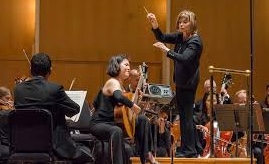 In 2022, the Buffalo Philharmonic Orchestra, under JoAnn Falletta’s directorship, along with flutist Amy Porter, and violinist Nikki Chooi serving as soloists, presented a well deserved centennial program devoted to the music and legacy of their one-time leader, including an October 3rd appearance that took center stage in New York’s Carnegie Hall. Shortly thereafter in Kleinhans Hall, Buffalo, their 74 minutes-worth of orchestral music that had been presented on that program formed the basis for a recording that is, to put it mildly, simply stellar in every way. As part of Naxos’ ongoing American Classics Series, this all-FOSS fest features four of the Master’s titles, which are, in order: Ode, for orchestra (1944, rev. 1958), Renaissance Concerto for Flute and Orchestra (1985), Three American Pieces for Violin and Orchestra (1944-45, orchestrated 1989), concluding with his four movement Symphony No. 1 in G Major (1944).
In 2022, the Buffalo Philharmonic Orchestra, under JoAnn Falletta’s directorship, along with flutist Amy Porter, and violinist Nikki Chooi serving as soloists, presented a well deserved centennial program devoted to the music and legacy of their one-time leader, including an October 3rd appearance that took center stage in New York’s Carnegie Hall. Shortly thereafter in Kleinhans Hall, Buffalo, their 74 minutes-worth of orchestral music that had been presented on that program formed the basis for a recording that is, to put it mildly, simply stellar in every way. As part of Naxos’ ongoing American Classics Series, this all-FOSS fest features four of the Master’s titles, which are, in order: Ode, for orchestra (1944, rev. 1958), Renaissance Concerto for Flute and Orchestra (1985), Three American Pieces for Violin and Orchestra (1944-45, orchestrated 1989), concluding with his four movement Symphony No. 1 in G Major (1944).
Fittingly, the release opens with Ode, an early opus by Foss that was composed during World War II in 1944. Running just a little over 10 minutes, Foss composed it in tribute to “those who will not return”. Dramatic as this rarely heard concert work remains, its orchestration is solidly crafted, appearing on this release in the version Foss revised into its final form in 1958. Within his scoring, Foss manages to showcase the orchestra; from solos to sectional passages, to expansive tuttis that Falletta and the Buffalonians toss off, both effortlessly, as well as idiomatically.
Following Ode comes one of the better known titles Foss penned, his Renaissance Concerto for Flute and Orchestra. On Buffalo’s current release, the flute soloist is Amy Porter, renowned Professor of Flute at the University of Michigan. In four delectable movements, this 20 minute work has enjoyed performances ever since its world premiere that occurred on 10 May 1986 by the person for whom it was composed, flutist Carol Wincenc, the Buffalo Philharmonic Orchestra, Lukas Foss conducting. (Yes, Foss himself recorded this opus a short time later during his Brooklyn Philharmonic Orchestra tenure, backing flutist Carol Wincenc on that release.) As its title implies, Foss drew inspiration, as well as certain strains of melody from the likes of Rameau (OK, so a little Baroque in there, too – note the title of the second movement), Monteverdi, Byrd, Melvill, that are reflected by the titles of its four movements, which are: Intrada, Baroque Interlude (after Rameau), Recitative (after Monteverdi), and finally Jouissance. While it contains some level to which it can be considered a “collage work”, a style of composition more closely associated with George Rochberg, Foss uses this mélange of materials in a manner that is completely personal, creating a fabric of sonority all its own; the “Renaissance” denoted as a period of time, nothing more. It is purely a tonally centered product of the 20th Century, featuring some extended techniques that propel the flutist’s level of expressivity ever forward.
 Past the skillful backing accompaniment provided by Buffalo and Falletta, on this recording, the star shines squarely on the magisterial shoulders of Amy Porter, whose commanding artistry is represented in full display of control, nuance, lyricism, and expression. While this work can come off as an uninspired foray into meaninglessness, such is not the case by way of this disc’s offering. In listening to this performance, it should come as no surprise that “Renaissance Concerto” has taken its well justified place among the most important concerti for flute from any period.
Past the skillful backing accompaniment provided by Buffalo and Falletta, on this recording, the star shines squarely on the magisterial shoulders of Amy Porter, whose commanding artistry is represented in full display of control, nuance, lyricism, and expression. While this work can come off as an uninspired foray into meaninglessness, such is not the case by way of this disc’s offering. In listening to this performance, it should come as no surprise that “Renaissance Concerto” has taken its well justified place among the most important concerti for flute from any period.
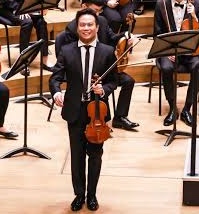 The next title on this release, Three American Pieces, also features a soloist, this time falling into the hands – and fingers – of violinist Nikki Chooi, the Buffalo Philharmonic Orchestra’s concertmaster. Dating from 1944-45, this may appear to be a bit more familiar to listeners since it has been assailed by various soloists in a variety of versions Foss prepared it for, ranging from its original for violin and piano, then violin and orchestra via its scoring in 1989 that became recorded by Itzhak Perlman….and there are postings of it on YouTube in one version, or another. Nevertheless, it remains cast in three short movements that bear the titles, in order: Early Song: Andante, Dedication: Lento, and Composer’s Holiday: Allegro. This delightful gem is chockfull of tunefulness, wit, craftsmanship, and charm. Foss cast his orchestral accompaniment for a smaller instrumentation than the other compositions on this release require; as transparent as anything by Mozart, or Haydn that demonstrates how delicately the Buffalonians can perform, expertly guided under Ms. Falletta’s baton. It is an additional pleasure that we now have Nikki Chooi’s splendiferously sure-footed rendering as soloist to add to anyone’s collection. Early as the source for his work is, there is a breezy quality to what Lukas composed, yet, while Copland is mentioned as having been an “influence”, there are other flavors and fragrances at play here all their own. The orchestrated version enhances them, supplying a foundation on which Nikki Chooi has captured all of its gracefulness, eloquence, and verve with distinction, and musicianship.
The next title on this release, Three American Pieces, also features a soloist, this time falling into the hands – and fingers – of violinist Nikki Chooi, the Buffalo Philharmonic Orchestra’s concertmaster. Dating from 1944-45, this may appear to be a bit more familiar to listeners since it has been assailed by various soloists in a variety of versions Foss prepared it for, ranging from its original for violin and piano, then violin and orchestra via its scoring in 1989 that became recorded by Itzhak Perlman….and there are postings of it on YouTube in one version, or another. Nevertheless, it remains cast in three short movements that bear the titles, in order: Early Song: Andante, Dedication: Lento, and Composer’s Holiday: Allegro. This delightful gem is chockfull of tunefulness, wit, craftsmanship, and charm. Foss cast his orchestral accompaniment for a smaller instrumentation than the other compositions on this release require; as transparent as anything by Mozart, or Haydn that demonstrates how delicately the Buffalonians can perform, expertly guided under Ms. Falletta’s baton. It is an additional pleasure that we now have Nikki Chooi’s splendiferously sure-footed rendering as soloist to add to anyone’s collection. Early as the source for his work is, there is a breezy quality to what Lukas composed, yet, while Copland is mentioned as having been an “influence”, there are other flavors and fragrances at play here all their own. The orchestrated version enhances them, supplying a foundation on which Nikki Chooi has captured all of its gracefulness, eloquence, and verve with distinction, and musicianship.
While it is not difficult to place Foss within his period of music’s history, his style is hard to define as being this, or that, of an “….ism”, or what-not. Eclectic? Yes, that in truth he was. Why? Why not!!! How? That’s easy – he knew the full spectrum of music’s Literature finding the commonality within the cumulative of it. He championed composers far more avant garde than he, many of whom numbered among his contemporaries while he did not always embrace their vocabulary, choosing instead to utilize which elements he desired to employ within a given work, driven by his own genius.
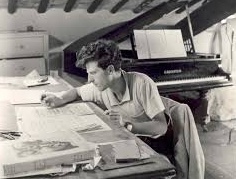
This release concludes with a spellbinding performance of Foss’ Symphony No. 1 in G Major that he composed in 1944, completing it that Thanksgiving (as stated so on its autograph score). He had just turned 22 that August. This youthful opus would have proven a triumph for anyone, even for a composer of 62, or 82 years of age, let alone Lukas Foss. In four movements, which are: Andantino – Un poco allegretto, Adagio, Scherzo – Vivace, and Andantino – Allegro, this ranks among the finest symphonies that belong to the World War II period; a period that includes Vaughan Williams’ Fifth, Martinu’s Third, Prokofiev’s Fifth, Bernstein’s 1st – Jeremiah”, Shostakovich’s 7th – Leningrad, David Diamond’s Second …..among others that have become more recognized, or universally acknowledged.
 For obvious reasons, this half-hour long Symphony No. 1 in G Major constitutes the largest, and longest work on this release, proving to be the perfect way for it to conclude. While movements 1, 2 and 3 range from six-and-a-half to seven minutes in duration, their continuity does not imply any aspect of them being slight. In totality, this symphony is tightly structured and masterfully orchestrated in a kaleidoscopic manner that allows the total forces of the Buffalo Philharmonic Orchestra to shine…..but, what about that fourth movement? Up to the point at which it begins, 21 minutes have already flown by, meaning that that final movement runs nearly ten minutes on its own. It could, in other words, exist as a stand alone work, yet, instead, it serves as the summation of its parts, just as a symphony of this nature requires. It may begin marked Andantino, however, it picks up speed before gathering yet more speed as it brings this masterpiece running head-long into its well earned, and explosive gun-shot-like conclusion.
For obvious reasons, this half-hour long Symphony No. 1 in G Major constitutes the largest, and longest work on this release, proving to be the perfect way for it to conclude. While movements 1, 2 and 3 range from six-and-a-half to seven minutes in duration, their continuity does not imply any aspect of them being slight. In totality, this symphony is tightly structured and masterfully orchestrated in a kaleidoscopic manner that allows the total forces of the Buffalo Philharmonic Orchestra to shine…..but, what about that fourth movement? Up to the point at which it begins, 21 minutes have already flown by, meaning that that final movement runs nearly ten minutes on its own. It could, in other words, exist as a stand alone work, yet, instead, it serves as the summation of its parts, just as a symphony of this nature requires. It may begin marked Andantino, however, it picks up speed before gathering yet more speed as it brings this masterpiece running head-long into its well earned, and explosive gun-shot-like conclusion.
It is true that JoAnn Falletta and the Buffalo Philharmonic Orchestra are continuing to create an outstanding body of award winning recordings. To that discography, this All-Foss entry has to be placed in the company of the very best among them. One can almost state that this constitutes a high watermark for Maestra Falletta who is on top of everything – from tempo changes, to dynamic fluctuations, subtleties, nuance, ranges in mood, intensity, and drama. Exactly, the whole human experience is conveyed sonically, brilliantly captured by the engineering team that put all of this together. Cutting to the chase, this is fantastic Foss from Falletta and Buffalo! Apart from their followers, Fossians worldwide will want to add this one to their collection. Why? This is one of the finest, and most vital representations of a major – yet neglected – composer to have come out within the last decade. Naxos has to be given credit for seeing this one through towards its commercial release and availability over various platforms.
Returning to my personal experiences with the great Mr. Foss. Past that unfortunate encounter mentioned earlier, I did not get to know him better until I was asked to work on a project with him. By that time, he was well up in years, yet still teaching in Boston, and still playing piano superbly. We stayed in contact after that project had become completed. I had the great pleasure of having visited him at his Bridgehampton home, and we spoke by phone thereafter, always on Tuesday mornings. It was my great pleasure of having been in attendance for his last Carnegie Hall performance where he appeared as the piano soloist for a Mozart concerto. The last time I visited with him was in his New York City apartment. As I left from that visit, I had the feeling that that would he the last time I would see him, which, alas, proved to have been the case. When Lukas passed away in 2009, I was unable to say goodbye, let alone to offer any sort of eulogy, nor anything else related to that. Perhaps that was not the time to have done so.
Memories of him have remained, especially with regard to the Symphony included on this current Naxos recording. First, this lead in that Lukas shared with me: since Lukas served as pianist with/for the Boston Symphony Orchestra, he was present for the rehearsals of the then brand new Concerto for Orchestra by Bela Bartok. Since Bartok’s opus does not call for piano, Lukas joined the composer during its first rehearsal when he encountered its original ending. Seeming to sound a bit abrupt, Foss asked Bartok about that, to which Bartok replied: “Doesn’t folk music often just end?” Shortly after its world premiere, Bartok composed the ending it has enjoyed ever since; Lukas beaming as he implied that he may have had something to do with Bela’s post-premiere decision!
In terms of Lukas’ Symphony No. 1 in G Major specifically, Fritz Reiner invited Lukas to visit him at his Connecticut home to discuss the score since Reiner had scheduled it for its world premiere (that occurred by the Pittsburgh Symphony Orchestra under his baton on 4 February 1945). When he arrived, he found Bartok also visiting. Reiner mentioned to Bartok that “….this young man and I have some work to discuss”, to which Foss mentioned to Bartok that he was invited to stay since he would welcome any of his comments. Bartok refused stating that “I never offer comments to composers – it is your work, which is none of my business” – the reason Bartok never taught composition. He proceeded to walk around Reiner’s garden until Fritz and Foss had completed their discussion. Once this afternoon in 1944 had concluded, Lukas remembered that Bartok and he rode the train back to New York together, but could not recall what they had talked about during it – a train ride I SO wish I could have taken with them, for sure.
….and what else? There were the Stravinsky stories, his Iron Curtain tour tales with Aaron Copland reflections, and more. In terms of that Copland tour, this dynamic duo eventually wound up in Berlin when one of the journalists asked Lukas how it felt to be “home”, to which he replied (paraphrasing here): “Not much. Ask me later when I have landed in New York; then I’ll be home.” One thing I could never understand was his disdain for the music of Satie, and Rachmaninoff, yet, when I asked him about Paul Hindemith, he replied that “….his was some of the first ‘modern’ music I had heard that didn’t suck.”
In conclusion, what I truly miss is that I did not get the opportunity to properly say goodbye to Lukas. Truthfully, you rarely get the opportunity to state that anyway, to anyone, even to those with whom you are close. This latest Naxos Falletta/Buffalo release has provided me with a deep sense of closure, as well as the pleasure these masterpieces bestow to embrace within my collection. What better recommendation for this recording can there be than that?
Dana Paul Perna, July 1, 2024
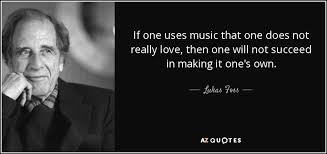
Category Sound | Tags:
Comments Off on Music of Lukas Foss – A Recording Review and Reflective Tribute by Dana Paul Perna
Sorry, comments are closed.

